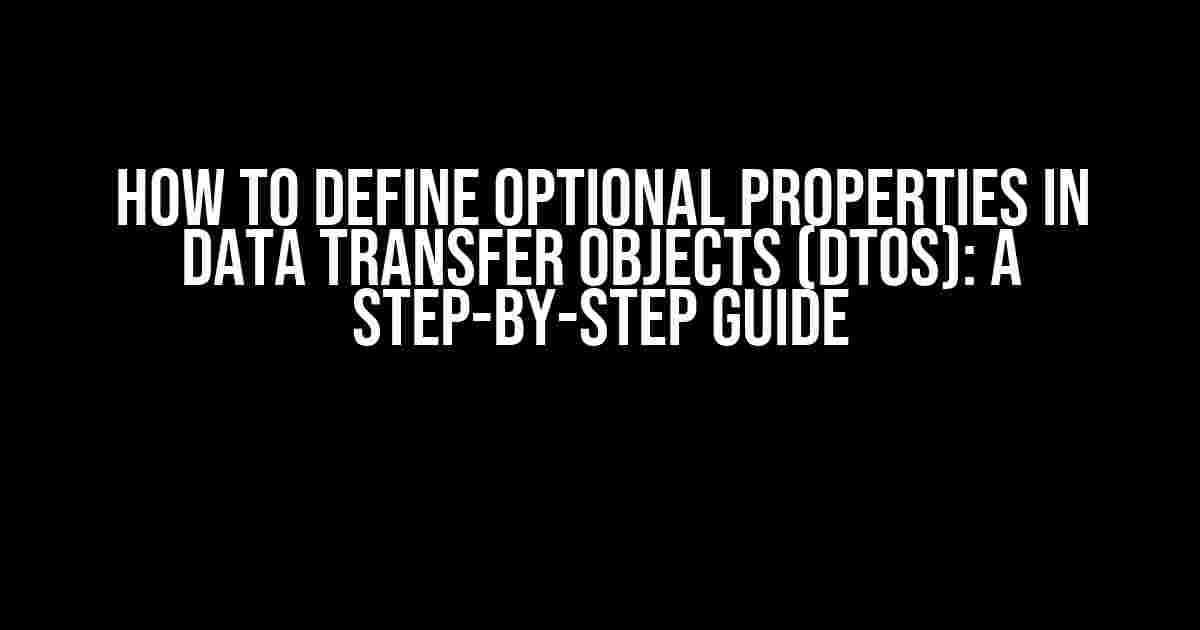Data Transfer Objects (DTOs) are a fundamental concept in software development, particularly when it comes to API design and data exchange between systems. One common challenge developers face when working with DTOs is handling optional properties. In this article, we’ll delve into the world of DTOs and explore the different approaches to defining optional properties. Buckle up, and let’s dive in!
What are Data Transfer Objects (DTOs)?
Before we dive into the main topic, let’s quickly review what DTOs are and their purpose. A Data Transfer Object (DTO) is an object that carries data between processes or systems. In other words, DTOs are lightweight objects used to transfer data between layers or systems, typically in a language-agnostic format like JSON or XML.
DTOs are essential in API design because they provide a standardized way to exchange data between the client and server. By using DTOs, developers can decouple the data format from the underlying business logic, making it easier to maintain and evolve the system over time.
The Problem with Optional Properties in DTOs
When designing DTOs, developers often face the challenge of handling optional properties. Optional properties are fields that may or may not be present in the data, depending on the context or scenario. For example, in a user registration DTO, the “middle name” field might be optional, as not all users have a middle name.
The problem arises when trying to define and work with these optional properties. If not handled properly, optional properties can lead to:
- Null pointer exceptions or errors
- Inconsistent data representation
- Difficulty in data validation and serialization
Approaches to Defining Optional Properties in DTOs
Luckily, there are several approaches to defining optional properties in DTOs. We’ll explore the most common methods, highlighting their pros and cons.
1. Using Nullables
One straightforward approach is to use nullable types for optional properties. In languages like C# or Java, you can simply declare the property as nullable, like this:
public class UserRegistrationDTO {
public string FirstName { get; set; }
public string LastName { get; set; }
public string? MiddleName { get; set; }
}Pros:
- Easy to implement
- Works well with JSON and XML serialization
Cons:
- Nullable types can lead to null pointer exceptions if not handled properly
- May not be suitable for languages that don’t support nullable types
2. Using Default Values
Another approach is to assign default values to optional properties. This way, even if the property is not present in the data, it will still have a default value.
public class UserRegistrationDTO {
public string FirstName { get; set; }
public string LastName { get; set; }
public string MiddleName { get; set; } = string.Empty;
}Pros:
- Avoids null pointer exceptions
Cons:
- May lead to inconsistent data representation
- Default values can be misleading or confusing
3. Using Separate Classes or Interfaces
A more robust approach is to define separate classes or interfaces for optional properties. This method involves creating a base class or interface that contains the required properties and then creating a separate class or interface that extends or implements the base class, adding the optional properties.
public interface IUserRegistrationDTO {
string FirstName { get; set; }
string LastName { get; set; }
}
public class UserRegistrationDTO : IUserRegistrationDTO {
public string FirstName { get; set; }
public string LastName { get; set; }
}
public class ExtendedUserRegistrationDTO : UserRegistrationDTO {
public string MiddleName { get; set; }
}Pros:
- Encourages a more modular and scalable design
- Allows for easier maintenance and evolution of the system
Cons:
- More complex to implement and maintain
- May lead to a larger number of classes or interfaces
4. Using Dynamic Objects or ExpandoObjects
In some cases, you might want to use dynamic objects or ExpandoObjects to handle optional properties. This approach allows you to add or remove properties at runtime, making it ideal for scenarios where the data structure is unknown or dynamic.
public class UserRegistrationDTO {
public string FirstName { get; set; }
public string LastName { get; set; }
public dynamic AdditionalProperties { get; set; }
}Pros:
- Flexible and adaptable to changing data structures
- Easy to implement and maintain
Cons:
- May lead to performance issues or security vulnerabilities
- Can be challenging to work with and debug
Best Practices for Defining Optional Properties in DTOs
When defining optional properties in DTOs, keep the following best practices in mind:
- Use meaningful and descriptive names for optional properties. This helps to avoid confusion and ensures that the property’s purpose is clear.
- Document optional properties thoroughly. Provide clear documentation on the optional properties, including their purpose, data type, and any constraints or validation rules.
- Use a consistent approach throughout the system. Stick to a single approach for handling optional properties to ensure consistency and maintainability.
- Test thoroughly. Thoroughly test your DTOs with different scenarios, including optional properties, to ensure that they work as expected.
- Consider using a DTO generator or tool. Tools like AutoMapper orSwagger Codegen can help generate DTOs and handle optional properties automatically.
Conclusion
Defining optional properties in Data Transfer Objects (DTOs) is a crucial aspect of API design and development. By understanding the different approaches and best practices, you can create robust and maintainable DTOs that effectively handle optional properties. Remember to choose the approach that best fits your system’s requirements and consider using a consistent and well-documented approach throughout your codebase.
With this guide, you’re now equipped to tackle the challenge of optional properties in DTOs and create scalable and efficient APIs that meet the demands of modern software development.
| Approach | Pros | Cons |
|---|---|---|
| Using Nullables | Easy to implement, works well with JSON and XML serialization | Nullable types can lead to null pointer exceptions, may not be suitable for languages that don’t support nullable types |
| Using Default Values | Avoids null pointer exceptions, defaulted values can be useful for certain scenarios | May lead to inconsistent data representation, default values can be misleading or confusing |
| Using Separate Classes or Interfaces | Encourages a more modular and scalable design, allows for easier maintenance and evolution of the system | More complex to implement and maintain, may lead to a larger number of classes or interfaces |
| Using Dynamic Objects or ExpandoObjects | Flexible and adaptable to changing data structures, easy to implement and maintain | May lead to performance issues or security vulnerabilities, can be challenging to work with and debug |
This article provides a comprehensive guide to defining optional properties in Data Transfer Objects (DTOs). By understanding the different approaches and best practices, developers can create robust and maintainable DTOs that effectively handle optional properties.
Frequently Asked Question
Struggling to define optional properties in Data Transfer Objects (DTOs)? Don’t worry, we’ve got you covered! Here are the answers to the most pressing questions:
What are optional properties in Data Transfer Objects?
Optional properties in DTOs are fields that can be absent or null in the data transfer process. They are not mandatory and can be skipped during serialization or deserialization, depending on the specific use case.
How do I define an optional property in a DTO using C#?
In C#, you can define an optional property in a DTO by using a nullable type or a default value. For example, you can use the ‘?’ operator to make a value type nullable, like this: public int? OptionalProperty { get; set; }. Alternatively, you can use a reference type and assign a default value, like this: public string OptionalProperty { get; set; } = string.Empty;.
Can I use optional properties in JSON DTOs?
Yes, you can use optional properties in JSON DTOs. In JSON, optional properties can be represented as absent or null values. When serializing a JSON DTO, the optional properties will be omitted if they have a null or default value.
How do I handle optional properties during deserialization?
During deserialization, optional properties can be handled by using a default value or by ignoring the absence of the property. You can use a deserialization library that supports optional properties, such as Newtonsoft.Json, which provides features like default values and nullable reference types.
What are the benefits of using optional properties in DTOs?
Using optional properties in DTOs provides flexibility and scalability to your data transfer process. It allows you to handle varying data sets, reduces errors, and improves performance by reducing the amount of data being transferred.


